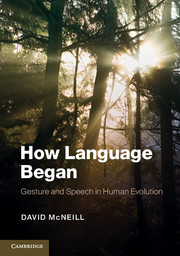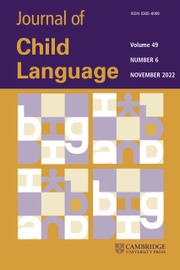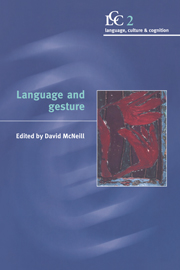How Language Began
Gesture and Speech in Human Evolution
Part of Approaches to the Evolution of Language
- Author: David McNeill, University of Chicago
- Date Published: September 2012
- availability: This ISBN is for an eBook version which is distributed on our behalf by a third party.
- format: Adobe eBook Reader
- isbn: 9781139558471
Find out more about Cambridge eBooks
Adobe eBook Reader
Other available formats:
Hardback, Paperback
Looking for an examination copy?
This title is not currently available for examination. However, if you are interested in the title for your course we can consider offering an examination copy. To register your interest please contact [email protected] providing details of the course you are teaching.
-
Human language is not the same as human speech. We use gestures and signs to communicate alongside, or instead of, speaking. Yet gestures and speech are processed in the same areas of the human brain, and the study of how both have evolved is central to research on the origins of human communication. Written by one of the pioneers of the field, this is the first book to explain how speech and gesture evolved together into a system that all humans possess. Nearly all theorizing about the origins of language either ignores gesture, views it as an add-on or supposes that language began in gesture and was later replaced by speech. David McNeill challenges the popular 'gesture-first' theory that language first emerged in a gesture-only form and proposes a groundbreaking theory of the evolution of language which explains how speech and gesture became unified.
Read more- Introduces a groundbreaking theory of how language began
- Critically examines a wide range of accounts, from cognitive science, linguistics, neuroscience and the psychology of language
- Complete with 50 illustrations depicting gestures and signs
Reviews & endorsements
'Long before embodied cognition was a recognized field of study, David McNeill was demonstrating the inseparability of language and gesture. In this new work he extends this pioneering approach to encompass the origins of human language.' Elena Levy, University of Connecticut
See more reviews'… grounded in the expertise of more than three decades of studying gestures with speech, this book will significantly change the scholarly debates on language evolution.' Cornelia Müller, Professor of Applied Linguistics, European University Viadrina, Frankfurt (Oder)
Customer reviews
Not yet reviewed
Be the first to review
Review was not posted due to profanity
×Product details
- Date Published: September 2012
- format: Adobe eBook Reader
- isbn: 9781139558471
- contains: 167 b/w illus. 11 tables
- availability: This ISBN is for an eBook version which is distributed on our behalf by a third party.
Table of Contents
1. Introduction - gesture and the origin of language
2. What evolved (in part) - the Growth Point
3. How it evolved (in part) - Mead's Loop
4. Effects of Mead's Loop
5. Ontogenesis in evolution - evolution in ontogenesis
6. Alternatives, their limits, and the science base of the Growth Point.
Sorry, this resource is locked
Please register or sign in to request access. If you are having problems accessing these resources please email [email protected]
Register Sign in» Proceed
You are now leaving the Cambridge University Press website. Your eBook purchase and download will be completed by our partner www.ebooks.com. Please see the permission section of the www.ebooks.com catalogue page for details of the print & copy limits on our eBooks.
Continue ×Are you sure you want to delete your account?
This cannot be undone.
Thank you for your feedback which will help us improve our service.
If you requested a response, we will make sure to get back to you shortly.
×










